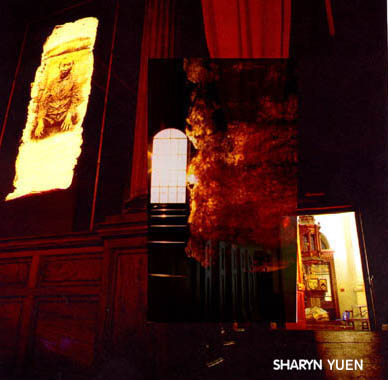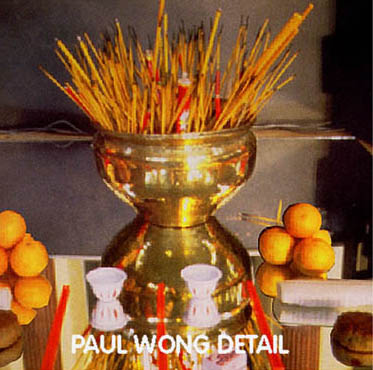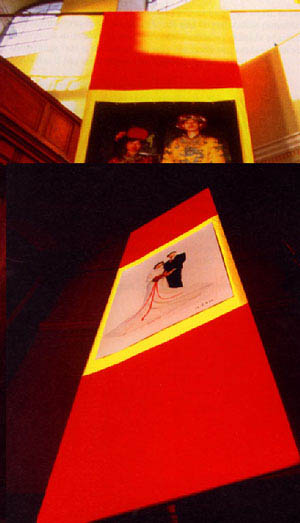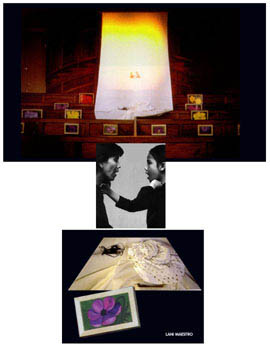
|
SHARYN YUEN The impetus for this series of six panels was a desire to look at women who I am akin to as a means to reconstitute my own life. Images taken from my mother's photo album and those which I have personally taken are my source of reference. As I started to work on this piece I began to further investigate the experience of these women and I could not help but to do a comparison of these women's lifestyles with my own: the choices, the opportunities which are different or those which are similar. I look at the changes of attitudes from one generation to the next one. |

|
PAUL WONG Chinaman's Peak is the name of a mountain in the Canadian Rockies. Walking The Mountain (Hanng San), in Cantonese, refers to the beliefs and rituals associated with ancestral worship. Ancestral worship continues to be an important part of contemporary Chinese culture. It provides continuity between the past, present and future, and between the living and those in the spirit world. Chinaman's Peak is a geographic, physical and metaphorical place that frames this story. Walking The Mountain appeases the hungry ghosts of those who came before. Specifically honoured in this work are the spirits of the Chinese pioneers, the railway workers in the late 1800's, the miners at the turn-of-the-century, the sojourner Hoy Ming Wong (1896-1968), and the suicides of Kenneth Fletcher (1954-1978) and Paul Speed (1967-1991). These seemingly isolated people and histories are united through death and the communal act of remembering. MEMORY YOU ARE A GOOD SPIRIT YOUR SPIRIT WILL ALWAYS BE REMEMBERED This work is a constructed and evocative hybrid narrative . Its making constitutes a necessary part of the healing process of allowing the ghosts to rest. |

|
PERFORMANCE Walking The Mountain refers to the beliefs and rituals associated with ancestral worship and respect for the dead. The performance utilized the graveyard of All Saints' Church and consisted of traditional and additional rituals and elements associated with ancestral worship. These were performed at some of the selected grave sites. Rituals at gravestone included tending of the grave site: demarcation, grave sweeping and the placement of candles on the tombstones. The elements of fire, earth, air and water, smell, taste, noise and visual components were included. "After the last burial here in 1862, the churchyard fell into disorder. Later a benefactor, a ship owner in the tradition of Roger Thornton, improved it at his own expense in 1882". It is now three generations since the last burial and presumably the graves and the spirits of those who came before have long been forgotten. The performance attempted to recover the lost histories and tend the gravestones left untended for decades. Traditional and contemporary Chinese and non-Chinese rituals, forms and styles were used in this hybrid work. Pre-production time was spent learning about the regional and specific histories of the geographic site and culture, and the histories of the deceased, religions and related death rituals. Christianity/Buddhism, eastern/western, orthodox and unorthodox practises contributed to a cross-generational and cross-cultural experience. The legacy of colonialism, and specifically insidious Christianity, continues to interrupt and destroy other belief systems. From the First Nations Peoples in the Americas, to Aboriginal Peoples in Australia, New Guinea to Africa, all of these cultures included ancestral worship, rituals that recognized human life as part of the larger universal world. Belief systems based on respecting the environment, regeneration and renewal. Christianity has refused to appreciate and understand how these beliefs were/are central to the cultures. In almost all cases, missionaries have tried to obliterate these practises, in many cases banning them. These practises were considered pagan, superstitious, as sorcery and witchcraft. 1/5 of the world population is Chinese. It is the oldest continuous civilization. Chinese customs and variations have been practised throughout Asia. 1/5 of the world population is caucasian. Yet, European western values continue to dominate and exploit the other 4/5ths of the world. Walking The Mountain, ancestral worship, has been an intrinsic part of my cultural heritage and experience. I participated in these rituals at the early age of 11 or 12. This was in 1968 at the time of my father's death. The shock and grief of death, the clash of western burial procedures interspersed with unexplained Chinese rituals only added to the confusion, mystique and fear of death. In 1982, I made the first of several journeys to China. The reunification of family members, the pilgrimage to family villages, locating of ancestral burial sites and graveside rituals to honour those in the spirit world were important events. In 1986, I spent an extended period in China videotaping materials that were released in 1988 as a feature length work, titled Ordinary Shadows, Chinese Shade. Within that longer work is a short section subtitled Hanng San, Walking The Mountain. Only during the construction and editing of the materials did I begin to focus upon, and to start to understand, the rituals connected with ancestral worship and appreciate its relationship to Chinese culture. In the summer of 1992, I was artist-in-residence at the Banff Centre for the Arts. During that time I intuitively produced Chinaman's Peak: Walking The Mountain. The work-in-progress included a television broadcast, an installation and a performance. |

|
HENRY TSANG In the fall of 1990, my partner, Karin Lee, and I travelled to China where we had our photographs taken at the Summer Palace near Beijing. For a small fee, we donned Imperial robes and posed in the fashion of a traditional Chinese Royal Couple. When we went to Shanghai, we visited a professional photo studio and were photographed in the style of a traditional western wedding portrait. The resulting images appear "natural", insomuch that they fit neatly within well-defined categories of coupling: one within the context of a tourist snapshot, the other within the well-honoured institution of marriage. Yet the situation is much more complex. That two North Americans, one by birth (four generations), the other by naturalization (I was born in Hong Kong), travelled to a foreign land that could questionably be considered "home" to have their portraits as a couple, taken with such authority. The two photographs contrast as much as they mirror each other. |

|
LANI MAESTRO Become Sound is derived from the dictionary definition of the word, to heal. My interest in autobiographical practices in art and its reparative potential has initiated this interest in exploring ways of communicating outside of articulated language, something that is rooted in the way the body responds physically and psychically to what it has internalized in response to the social. The idea of embodying sound attracts me as a way of integrating our perception of the world into a deeper felt experience. This would lead, perhaps, to a better understanding of our relationship to ourselves, our relationship to others outside ourselves and the relationship to others within ourselves. |
More Back Essay